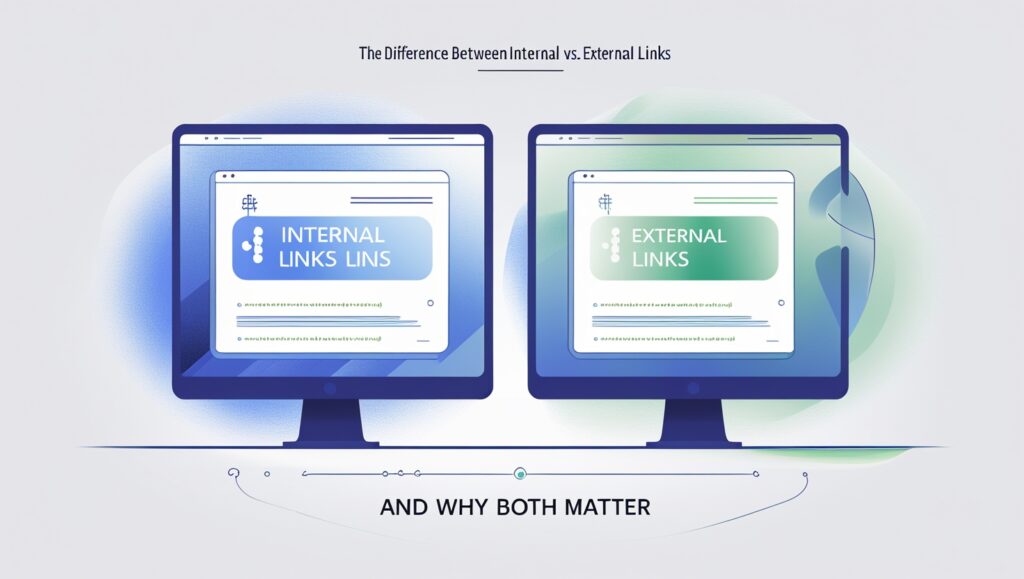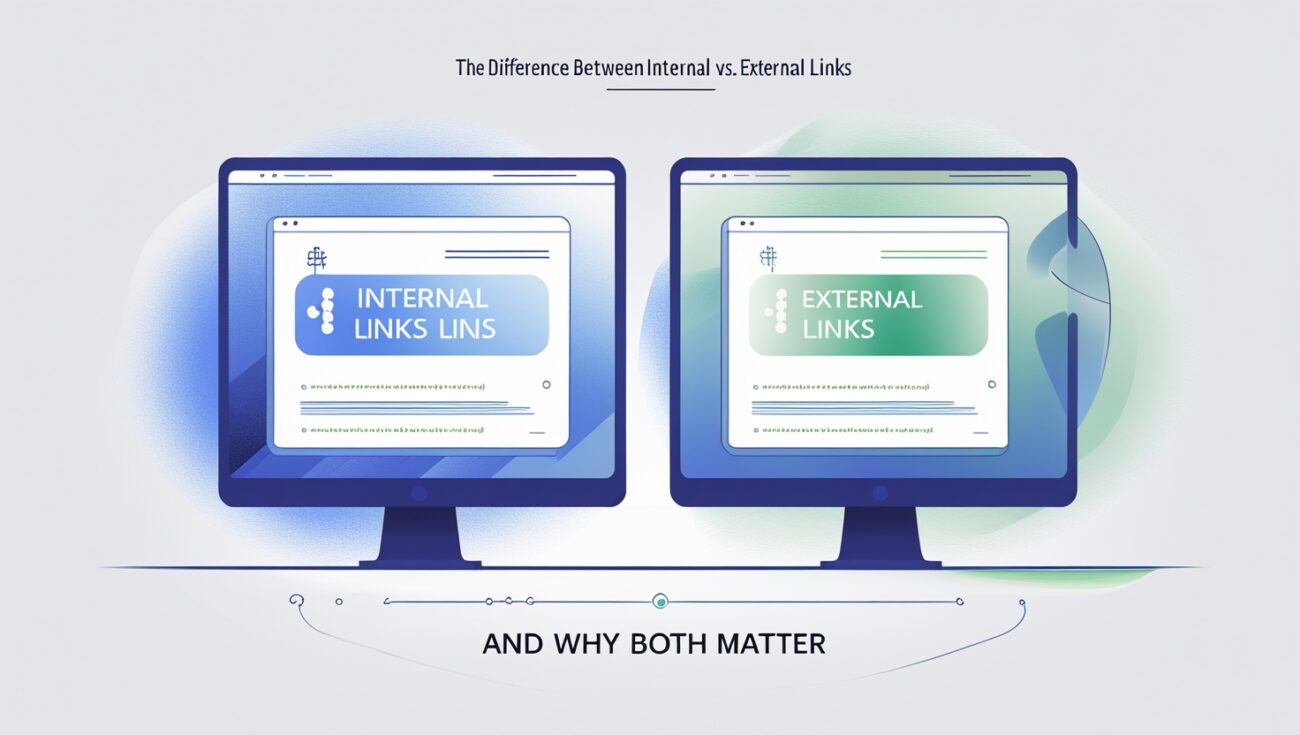The Difference Between Internal vs. External Links (And Why Both Matter)
When I first started learning about SEO, the concepts of internal and external links seemed confusing. They both looked like blue, clickable words on a page. I quickly realized, however, that while they look similar, they serve two fundamentally different purposes in the world of SEO. Understanding these roles is the key to building a comprehensive and effective strategy that helps your website rank higher and attract more traffic.

Table of Contents
I’ve come to think of them as two sides of the same coin. Internal links are your blueprint, defining your site’s architecture and guiding your visitors. External links (often called backlinks) are your reputation, a signal from the outside world that you are a trustworthy and authoritative source. Neglecting one in favor of the other is a common mistake that can hold your website back. Let me break down the critical differences and explain why you need to master both.
Understanding Internal and External Links in SEO (and Why Both Matter for Rankings)
When I first started learning SEO, I kept hearing about internal and external links, but I didn’t really understand how they worked together. Now that I’ve optimized several websites, I can tell you — knowing the difference between internal and external linking is one of the most important skills you can learn.
Let’s start with the basics. Internal links and external links both connect web pages, but they serve different purposes. Internal linking happens when you link from one page on your own website to another page within the same domain. For example, linking from your blog post to another related article or a product page. External linking, on the other hand, connects your site to a completely different domain. In short, internal vs external links comes down to whether the link stays inside your site or points outside.
In SEO, both are crucial. Internal linking and external linking help search engines understand your site’s structure, relevance, and authority. When I optimize a post, I always use a balance of internal and external links in SEO to build trust and improve indexing. Google crawlers love well-connected pages.
To put it simply, what is internal link and external link in SEO? Internal links guide users (and Google) through your content, helping distribute authority and improving engagement. External links, meanwhile, show credibility — especially when you reference reliable sources. That’s why you’ll often hear people talk about backlinks vs external links; backlinks are external links coming into your site, while external links are going out to others.
Even in code, the difference between internal and external linking in HTML is simple. An internal link in HTML points to a page on your same domain (like /about), while an external link uses a full URL (like https://example.com). Understanding this helps when you’re distinguishing between internal and external linking from a technical perspective.
What Are Internal Links?
Internal links are hyperlinks that connect one page on your website to another page on the same website. Think of them as the web of connections you have full control over. They are the pathways that allow search engines and users to navigate your site.
Their primary purpose is to:
- Build a Clean Site Structure: A logical internal link profile creates a clear hierarchy for your content, making it easy for search engine crawlers to discover and understand every page on your site.
- Distribute Link Equity: When a page on your site has authority (either from external links or its own popularity), it can pass some of that valuable link equity to other pages through internal links, boosting their ranking potential.
- Guide the User Journey: A strategic internal link helps a user find the next logical piece of information, keeping them engaged on your website for longer.
This is a powerful tool because you have 100% control over it. You decide where the links go, what the anchor text says, and how many to include. Automated tools like Linkbot make it incredibly easy to manage your internal links and build a strong site structure.
What Are External Links (Backlinks)?
External links are hyperlinks from a page on one website to a page on a different website. When a third-party website links to yours, that is called a backlink. These are essentially votes of confidence from other websites.
Their primary purpose is to:
- Signal Authority and Trust: The more high-quality and relevant external links you have pointing to your site, the more trustworthy and authoritative search engines believe you are.
- Drive Referral Traffic: A good external link can send a stream of qualified visitors from a different website directly to your content.
You have very little control over external links. You can’t force another website to link to yours; you have to earn those links through great content, networking, and outreach.
From a strategy point of view, internal vs external link optimization should always favor a strong internal structure first. Without it, external backlinks won’t perform as well. That’s exactly why I started using Linkbot — it automates internal linking across my entire site so I can focus more on outreach and external link building.
If you’ve ever wondered what are internal and external links, think of them like this: internal links strengthen your own ecosystem, and external links expand your reach. Both work together to create trust and context. But internal links are something you can control completely — and with a tool like Linkbot handling automated internal linking, your site stays perfectly optimized while you work on content growth.
So, what is the difference between internal and external linking in SEO? Internal links keep users and authority flowing through your pages. External links build credibility with the wider web. In the end, it’s not external vs internal links — it’s about using both strategically to create a well-balanced, SEO-friendly site.
The Key Differences: Control, Purpose, and Authority
- Control: You have complete control over your internal links. You have to earn your external links.
- Purpose: Internal links are for site organization, user navigation, and distributing authority internally. External links are for earning authority and credibility from the outside world.
- Authority Flow: Internal links distribute authority within your website. External links bring authority to your website.
Why You Can’t Have One Without the Other
A strong SEO strategy requires a balanced approach to both.
- A website with great internal links but no external links is like a well-organized library in the middle of a desert. The books are perfectly categorized, but no one knows it exists.
- A website with great external links but a messy internal link profile is like a famous but disorganized professor. They have a lot of credibility, but all their research is scattered and hard to find.
The real power comes from combining them. You earn authority from external links, and then you use your internal links to distribute that authority to your other valuable pages, boosting your entire site’s ranking potential.
Building a Balanced Strategy
- For Internal Links: Focus on building a clean, hierarchical site structure. Link from your high-authority pages to new and important content. Regularly audit for broken links and orphaned pages. This is a foundational task that can be easily managed with a powerful tool. I use Linkbot to manage my internal link profile, and it saves me countless hours.
- For External Links: Focus on creating genuinely valuable, high-quality content that other websites will naturally want to link to.
Conclusion: Two Sides of the Same Coin
Mastering SEO isn’t about choosing between internal or external links. It’s about recognizing that they are two distinct but equally crucial components of a winning strategy. Internal links are the foundation and the architecture you build from the inside out, and external links are the votes of confidence you earn from the outside in.
By taking control of your internal links and consistently working to earn high-quality external links, you can build a website that is both well-organized and highly authoritative. It’s the ultimate combination for long-term SEO success. You can start building your website’s strong foundation with Linkbot today.
The way I see it, the synergy between internal and external links is the ultimate expression of a great user experience. A strong internal linking profile ensures a user who lands on your site can easily find what they’re looking for, which satisfies the “Experience” part of Google’s E-E-A-T framework. The external links you earn, on the other hand, build the “Authority” and “Trust” that gives users confidence in your content from the moment they arrive.
It’s a powerful realization to know that a huge part of your SEO success is entirely within your control. While you can’t force another website to link to you, you can take full command of your internal links. By dedicating yourself to building a clean, logical site structure, you are laying the groundwork for your content to not only rank well but also to be a welcoming and trustworthy resource for your visitors.
Ultimately, the goal isn’t just to get one type of link over the other. It’s to build a self-reinforcing system. You create great content that earns external links, and then you use your internal links to spread that newly earned authority across your entire website. It’s a compounding process that makes your website more powerful, more visible, and more effective with every single link you add.

